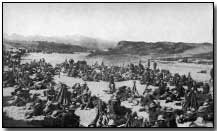Battles - The First Battle of Gaza, 1917
 With all
Turkish forces forced from the Sinai Peninsula in early January 1917
British-led forces, commanded by
Sir
Archibald Murray, were able to consider an assault into Palestine
itself.
With all
Turkish forces forced from the Sinai Peninsula in early January 1917
British-led forces, commanded by
Sir
Archibald Murray, were able to consider an assault into Palestine
itself.
In doing so - for it was quickly determined that a push towards Gaza was feasible, albeit under pressure from the British War Office - it was imperative that the British should first dislodge Turkish forces from commanding positions from a series of ridges between Gaza and Beersheba; these formed the only practical entry into Palestine. Turkish forces in Gaza, some 18,000 men, were commanded by German General Kress von Kressenstein.
The Turkish force was outnumbered two-to-one by forces led by General Sir Charles Dobell, Murray's subordinate and commander of Eastern Forces. Kressenstein was nevertheless ordered to hold the position by Djemal Pasha.
Dobell assembled the core of his force 8km from Gaza near the coast and behind the Wadi Ghazi. Advancing under the protection of a dense sea fog his cavalry successfully cut off the rear of Gaza east and south-east on the morning of the attack's launch, 26 March, meanwhile deploying so as to / prevent the supply of reinforcements to the town.
The central infantry advance, conducted by 53rd Infantry Division, was launched across difficult terrain from the ridge of Ali Muntar and was greatly assisted by the encircling cavalry.
Inexplicably with victory apparently in sight towards the end the of the day Sir Philip Chetwode withdrew his cavalry forces under orders from Dobell, the latter mistakenly believing that the infantry advance was proving a failure.
 Kressenstein
coincidentally arrived at the opposite conclusion and cancelled his own call
for reserves believing Gaza a lost cause.
Kressenstein
coincidentally arrived at the opposite conclusion and cancelled his own call
for reserves believing Gaza a lost cause.
Resumed again the next day the British unsurprisingly found that Kressenstein had hastily reinforced the town's permanent garrison of 4,000. A combination of Turkish counterattacks combined with a lack of water supplies finally persuaded Dobell to call off the attack.
In the encounter Dobell suffered 4,000 casualties set against approximately 2,400 Turkish losses. Disastrously however Murray wrote to the War Office in London suggesting Turkish losses to be three times their actual figure while implying that the battle was a clear-cut British victory (rather than the draw it was).
Murray's despatch convinced London of the potential success of operations on the Palestine Front. Murray was consequently ordered to launch a fresh assault at the earliest opportunity, with the target Jerusalem itself. Second time around Murray found his Turkish opponents ready and waiting.
To view maps charting the course of the three Gaza battles click here; and here; and here.
Photographs courtesy of Photos of the Great War website
Bulgaria mobilised a quarter of its male population during WW1, 650,000 troops in total.
- Did you know?
